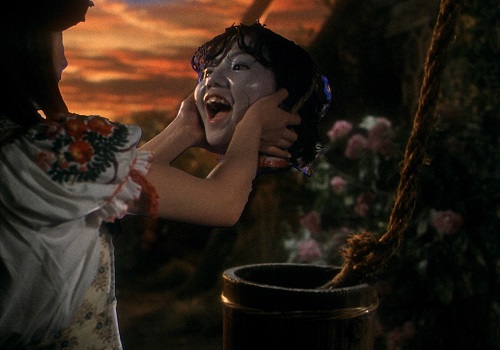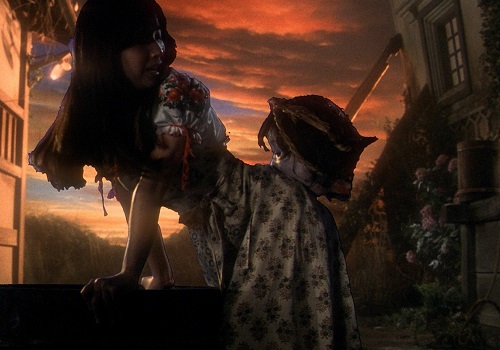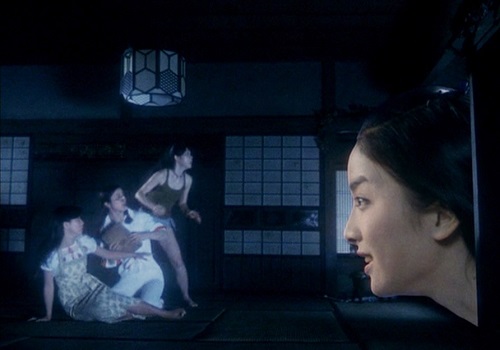WTH Just Happened?: House
Movies that Have to Be Seen to Be Believed
For all of its oddities, grotesqueries and eccentricities, the single strangest thing about Nobuhiko Obayashi’s House (Hausu) is probably its heritage. How does a legendary studio like Toho commission a film to capitalize on the success of Jaws and wind up with a haunted house flick? Forget the fact that House shares practically zero DNA with that august blockbuster beyond their medium. Even if we stack Obayashi’s gonzo spook-a-blast delight next to other films of its make—House on Haunted Hill, The Old Dark House, The Haunting, Kuroneko—his movie still looks like the black (or perhaps Technicolor) sheep of its family. This, apparently, is what happens when you turn to your preteen daughter for script ideas when making big screen summer entertainment.
The “what,” of course, is pure, demented genius, the kind of euphoric cinematic lunacy that can only be attained through devotion to a singular purpose. Bad movies happen to unsuspecting audiences all the time. (See: Pixels, The Gallows, Terminator Genisys.) Movies like House—movies that are unabashedly bananas and willfully shabby—happen much more rarely than that, and when they do happen they should be cherished. American genre diehards didn’t get a fair chance to embrace Obayashi’s 1977 work until the 2000s, when Janus Films scooped up the distribution rights to the film and gave it a theatrical run throughout North America (including two shows at the 2009 New York Asian Film Festival), which culminated in its release on home video via The Criterion Collection back in 2010.
For archaeological movie geeks—fans who take their fandom to “treasure hunter” status—that’s a blessing and a king bummer all rolled together. All that hard work put into cadging your way to a bootlegged copy of House has been made moot, and yet it’s so easy to see the movie now that aiming your imprecations at Criterion feels like just as much of a time waster. It should go without saying that their transfer looks light-years better than that raggedy-assed VHS tape you scored through the Internet forum equivalent of back-alley wheeling and dealing, and hey, if you never managed to secure one for yourself, now you can just run out to Barnes & Noble and snag one off the shelf in infinitely less time than it takes to scour auctions on eBay.
Put bluntly, if you’ve been absolutely dying to see the film since before the aughts, you’ve probably caught up to it by now. If you haven’t, you should, and if you don’t want to, then you should want to. House is a kooky gift to aficionados of the weird, but the film plays even for viewers with passing interest in intentionally funky international cinema, save those stricken by an irrational fear of floating severed heads.

Like this one. Surprise!
Let’s back up a bit as Fantasy (Kumiko Ohba) clutches the cackling animated noggin of poor old Mac (Mieko Satô) in her trembling hands, because we’ve gotten a good bit ahead of ourselves. House begins as our teenage heroine, Gorgeous (Kimiko Ikegami), receives an unwelcome surprise from her father, who has just returned home after laying down a movie score in Italy: He’s remarried following the death of Gorgeous’ mother years prior. She’s so upset at the arrival of her new and unwanted stepmom that she makes the impulsive decision to bail on the vacation she’d been planning with her dear old dad. Instead, she makes tracks to her distant aunt’s (Yoko Minamida) countryside manse, her six friends in tow, where things get spooky and the girls slowly come to fear for their lives.
They make quite an ensemble just for sheer volume, but Obayashi doesn’t go about splitting hairs with character nuances. Everybody here lives up to their name to the fullest extent, so we never have to worry about mixing up who’s who in House’s supporting cast. Prof (Ai Matsubara) is the group’s bespectacled brainiac; Fantasy is inclined to daydream; Kung Fu (Miki Jinbo) is a martial arts badass; Melody (Eriko Tanaka) plays the piano; Sweet (Masayo Miyako) is, well, sweet; and Mac “likes” to eat in the same sense that Godzilla “likes” to blithely stomp around downtown Tokyo. (Her very nickname derives from the word “stomach.”) That’s about it. House doesn’t demand a lot from its players other than that they fully embody the chief trait that defines who they are and have fun doing it.
So if you’re focusing too much on “character” here, you’re missing the point. Circling back around to the Jaws connection, House doesn’t have a Chief Brody, or a Quint, or even a Bruce the shark, as though we needed to add to the tally of things that Obayashi’s work lacks in common with Steven Spielberg’s. Nor does it have much by way of tension, or scares, or even a prevailing internal logic. (If Toho wanted to make that movie, or even a close cousin to that movie, they failed spectacularly.)
What it does have instead is ghastly ingenuity, seen in disembodied craniums of all shapes and sizes, man-shaped piles of bananas, one seriously evil cat, pratfalls, pitfalls, carnivorous pianos, slaphappy mattresses, a frenetically trippy soundtrack, a grandfather clock filled with blood, a living room filled with blood, garish special effects work that’s so cartoonish that “cartoonish” is a woefully inadequate way of describing them, and, of course, butt biting.

-

-

-

-

-

-

-

-

-

-

-

-

-

-

-

-

-

-

-

-

-

-

-

-

-

-

-

-

-

-

-

-

-

-

-

-

-

-

-

-













































